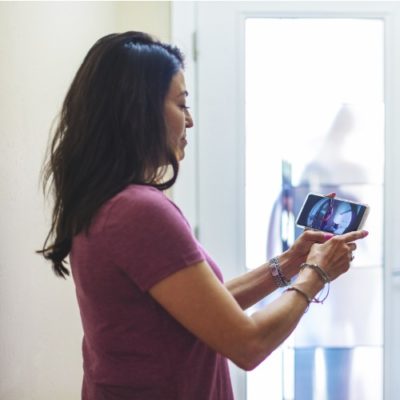- Does not require a Wi-Fi network
- Has cellular and battery backup
- Supports up to 160 sensors
- Works with Apple HomeKit
Our Top Pick: SimpliSafe
You don’t need a landline or holes drilled into your walls to protect your home.
We researched wireless security systems so you don’t have to. Of the systems we looked at, SimpliSafe really shined.
Its long wireless range creates a network out of all the sensors in your home (up to 80, in fact), and a backup battery keeps it running if the power goes out.
Add easy DIY installation and affordable monitoring rates, and you’ve got a recipe for the best wireless security system.
Best Wireless Home Security Systems
Best Wireless Security System Comparison
| Starting Equipment Price |
| Monthly Monitoring |
| Cellular Backup |
| Wire-Free Equipment |
| Hours of Backup Battery |
| Sensors Supported |
| Best Overall | Best for Budget | Best Customer Service | Techie Pick |
 |
 |
 |
 |
| $229.00 | $179.00 | $319.95 | $399,00 |
| $14.99 | $20.00 | $44.99 | $19.00 |
| Yes ✓ |
Yes ✓ |
Yes ✓ |
Yes ✓ |
| Yes ✓ |
Yes ✓ |
Yes ✓ |
Yes ✓ |
| 24 hrs. | 5 hrs. | 24 hrs. | 12 hrs. |
| Up to 80 | Up to 160 | Up to 80 | Up to 30 |
| Visit SimpliSafe | Visit Abode | Visit Frontpoint | Visit Kohl's |
Info current as of 08/24/20. Offers and availability may vary by location and are subject to change.
Our Approach
We looked at wire-free systems that use wireless connections like your home Wi-Fi network to connect equipment with your phone and the monitoring center. In our research, we found some big-name systems that claim to be wire-free but aren’t. More on that later.
For the truly wire-free systems we found, we compared connection strength, backup battery life, installation ease, and customer service in our testing. Pairing these factors with customer reviews gave us some helpful insights on the factors we found most important.
Finally, we contacted each of the companies with questions to see how helpful the reps are. One even gave us a promo code for $25 off at checkout (Thanks, Chidi from Frontpoint!).Read our methodology to find out how we conducted this and all our reviews.
Wireless Security System Reviews
SimpliSafe: Best Overall
If confusing equipment, pricing, and contracts have kept you from getting a home security system, SimpliSafe may be worth your time. Everything about this wireless alarm system, pricing, and equipment is easy to understand. Plus, there’s no calling for a quote or searching through small print and hidden fees.
SimpliSafe’s home security system starts at a one-time fee of $229.00 for equipment and $14.99 per month for professional monitoring. While equipment fees are due up front, there’s no contract or cancelation fee. So you can opt in and out of monthly monitoring fees as you wish.
SimpliSafe offers cellular backup, a 24-hour backup battery, and six multiple monitoring centers across the country to protect your home. It supports up to 80 sensors that detect movement up to 800 feet away from the base station (just over two football fields).
Plus, it doesn’t completely rely on Wi-Fi to connect its sensors, so a fickle internet connection won’t compromise your home’s security.
While SimpliSafe is an excellent system, it doesn’t have all the devices we’d like to see. It lacks an outdoor camera and a carbon monoxide detector. Like Abode, you need to pay a little more per month for professional monitoring and the app that comes with it. But its wireless strength is formidable, making it a reliable choice for homes (unless you live in a castle).
The Bottom Line
SimpliSafe tosses out the intimidating pricing and contracts found in other security systems. You start with long-range sensors and can easily add more devices later on to expand your coverage. Everything about SimpliSafe is straightforward. From pricing to equipment, what you see is what you get.
Read our full SimpliSafe review to learn more about equipment, plans, and pricing.
Pros
- Installs in under an hour
- Uses powerful long-range sensors
- Doesn't need Wi-Fi
- Doesn't require contract or cancelation fee
Cons
- Lacks home automation option
- Charges for mobile app access
Abode: Best for Budget
Abode’s home security system has a wireless connection strong enough to support an impressive amount of sensors and third-party products. The company also has its share of sensors, cameras, and devices to leave your home protected and connected. Plus, it’s a fraction of the cost of its competitors.
The basic system starts at $179, a steal compared to starter kits like Nest that cost more than double that up front. Professional monitoring is only $8 per month (less than most streaming services). You can even opt to self-monitor your system, but you’ll miss out on features like cellular backup (a big deal for a wireless system).
When paired with compatible smart products, you can create tons of automations with your Abode system through the CUE home automation engine. For example, it can kick on the thermostat when you unarm the system after work or keep the front light on at bedtime.
Abode makes programming your entire home as easy as microwaving popcorn (which you could probably coordinate with your automations too).
The Abode system hub supports an impressive 160 sensors max, including smart speakers like Apple HomeKit, Amazon Alexa, and Google Assistant. You can add Abode products like indoor and outdoor security cameras, motion detectors, and environmental sensors to your home automations too.
While this system is fantastic, its backup battery leaves something to be desired. With only five hours of juice available, it could leave your home vulnerable during a power outage or other emergency.
Abode’s Price and Connectivity
Abode comes with a low price and few risks. It’s a powerful wireless security system for folks in smaller homes who want to explore home automation. And while its backup battery needs improvement with only a five-hour lifespan, it’s still a quality system.
To learn more about Abode’s equipment, pricing, and installation process, read our full Abode review.
Pros
- Supports up to 160 sensors
- Works with third-party devices
- Provides affordable monitoring and equipment
Cons
- Has limited backup battery
Frontpoint: Best Customer Service
If customer service is as important to you as a dependable wireless connection and easy installation, Frontpoint wireless security is definitely worth your time.
Its website is transparent about pricing and equipment features, and you can easily find help if you have questions while shopping. The live chat option offers straightforward information without high-pressure sales tactics.
Frontpoint’s customer service stuck with us. We spoke with Chidi O., who responded quickly, clearly, and politely. He even gave us a code for an additional $25 off a Frontpoint system.
Frontpoint’s price is a little higher than Abode’s or SimpliSafe’s, but the system’s become more accessible since it requires no contract and offers financing options. Equipment packages start at $319.95, with monitoring at $44.99 per month. If you choose to finance, you can get a Frontpoint system with $0 down.
The system also has a ton of equipment options like security cameras with motion detection and two-way audio, motion and contact sensors, and fire and carbon monoxide detectors. There are fewer options for home automation through Frontpoint, but the company does have a few gadgets like a video doorbell to make your home smarter.
As a wireless alarm system, Frontpoint takes a slightly different approach than its competitors. This wireless system relies primarily on cellular signals rather than Wi-Fi, so you get a steadier, more reliable connection.
And in case of an emergency, your backup battery will last for 24 hours. Frontpoint also has backup monitoring centers if the nearest cell tower fails. So you’ll still be protected even if the cell signal fails. This strategy pays off because Frontpoint’s system can support up to 80 devices in your home.
Our Customer Service Experience
Frontpoint has quality equipment and flexible payment options, but what really made this wireless security company stand out is the customer service. We love the low-pressure, friendly approach of the rep we spoke with. Plus, you can opt for a no-contract option for a little extra up front.
Our full Frontpoint review dives deeper into Frontpoint’s security equipment.
Pros
- Doesn't require Wi-Fi
- Works 24 hours without power
- Trades high pressure sales for helpful customer service
Cons
- Professional monitoring is expensive
- Mobile app costs extra
Nest with Brinks: Techie Pick
Brinks and Nest teamed up to create a dynamic wireless security duo. You can pair a Nest Secure system with Brink’s professional monitoring and cellular backup. Monitoring costs land around $30 per month and you’ll need to buy the Nest system. But if you have the budget to afford this system and enough accessories to place around your home, it’s worth checking out.
The Nest Secure system comes with a main hub, two Nest Detect sensors (dual motion and contact sensors), and two key fobs to arm and disarm your system.
Nest Secure can connect to your Amazon Alexa and Google Home, as well as any other Nest products. This allows you to control anything from your doorbell to your thermostat through one system. Nest’s app is streamlined and simple, but it’s powerful enough to control multiple devices throughout your home.
Brinks uses its three redundant monitoring centers to keep an eye on your home. If your local cell tower fails to connect your system to the pros, another Brinks center can take over.
The system’s wireless connection doesn’t seem as strong as Abode, SimpliSafe, or Frontpoint, though. And it can support only 30 Nest Detects. But unless you have over 30 doors and windows to place them on, you probably won’t miss the extra room for more sensors.
How Nest and Brinks Work Together
The Nest-Brinks partnership may be confusing at first, but it’s pretty simple.
Basically, Nest provides the equipment while Brinks does the monitoring. You’ll have to pay up front for a Nest Secure system (around $399). Brinks offers two options for monitoring once you have your system. You can opt for a three-year contract and pay $19 per month or go month-to-month on your system for $29.
The best option depends on your level of commitment and budget, but we like that you don’t have to get into a contract if you don’t want to. Check out our full review on Nest and review on Brinks to learn more about each system.
Pros
- Three redundant monitoring centers
- Great equipment for home automation
Cons
- Charges a lot up front
- Supports fewer extra devices
- Lacks cellular backup or monitoring without Brinks
More Brands We Considered
We also considered a couple of security giants for our list of best wireless systems. Vivint and ADT both claim to have wireless security systems. But this isn’t totally true, at least not according to our wireless/wire-free definition.
Equipment from both companies uses wireless connections like your home Wi-Fi, radio signals, and cell signals. But they aren’t completely wire free.
Vivint’s SkyControl panel and more current Smart Hub control panel require installers to drill holes in your wall to connect to a power source. The newer Smart Hub requires a 12 VDC power source, making it only kind of wireless.
On the other hand, the cheapest ADT option requires a landline, or you can choose its cellular system for $44.99 and up for smart home capabilities. ADT requires a contract but Vivint lets you go contract-free if you drop a lot of money up front.
Both companies are worthy options if you want a recognizable, professionally installed home security system. But they both have confusing pricing, policies, and contracts that could lock you in for several years, and neither fits our definition of wireless.
What to Look For in a Wireless Security System
Connection Strength
Wireless systems tie sensors throughout your home together with different types of signals. The best wireless home security systems can support over 30 individual sensors, a feat that requires a strong wireless signal. A secure connection like this doesn’t just mean more gadgets, but also faster notifications and smoother system control.
Backup Battery Life
If an intruder cuts off the phone or power supply to your system, it’s toast. But the battery backup found in wireless alarm systems keeps the power running for up to 24 hours. So if there’s an emergency like a power outage or tampering, your system is still up and running.
Installation Ease
In our book, wireless also means wire-free. Shedding the wires makes installation easier and safer. Plus, skipping the landline, wired control panels, and wired sensors makes your system safe from tampering.
Final Word: No Wires Required
Wireless home security systems are becoming a popular choice nationwide. It’s easy to see why. Wireless systems make home automation easier, have several methods of backup in an emergency, and are easier to install.
If you’re considering cutting the cord on your hardwired security system or buying a system for the first time, consider one of the best wireless home security systems like SimpliSafe, Abode, or Frontpoint.
Wireless security systems are just the tip of the iceberg. Check out our favorite self-installed security systems or learn more about self-monitored systems if you’re curious about cutting cords to traditional security systems. There are also more smart security systems out there if you’re interested in home automation.
Wireless Security System FAQ
What is cellular backup?
Wireless security systems use radio signals, cellular towers, and Wi-Fi to connect your security equipment to your phone and the monitoring center.
If your Wi-Fi or power goes out, the signals from cellular towers keep these devices online and in contact with the monitoring center, keeping you covered even without power.
Will my system work if my power and Wi-Fi go out?
If a storm knocks out your power, your Wi-Fi won’t work. That’s where cellular and battery backup come in.
Battery backup keeps your security system up and running for anywhere from 5 to 24 hours (depending on your system). Cellular backup keeps your system linked to the monitoring center so professionals can still watch your home in case of an emergency.
Will my security camera work with a wireless security system?
Yes. Once you’ve set up the camera and connected it to the system, you can watch your camera feed through the app of your chosen wireless security provider.
Can intruders tamper with my wireless security system?
No system is completely fool-proof, but wireless systems are less vulnerable to tampering than traditional landline or wired systems.
With no cords to unplug or cut, intruders have to be inside to damage your security system. Even if they unplug your system hub, wireless systems have cellular and battery backup, so the monitoring professionals would know before you do.
The post Best Wireless Security Systems appeared first on SafeWise.
Aricle source here: Best Wireless Security Systems





No comments:
Post a Comment